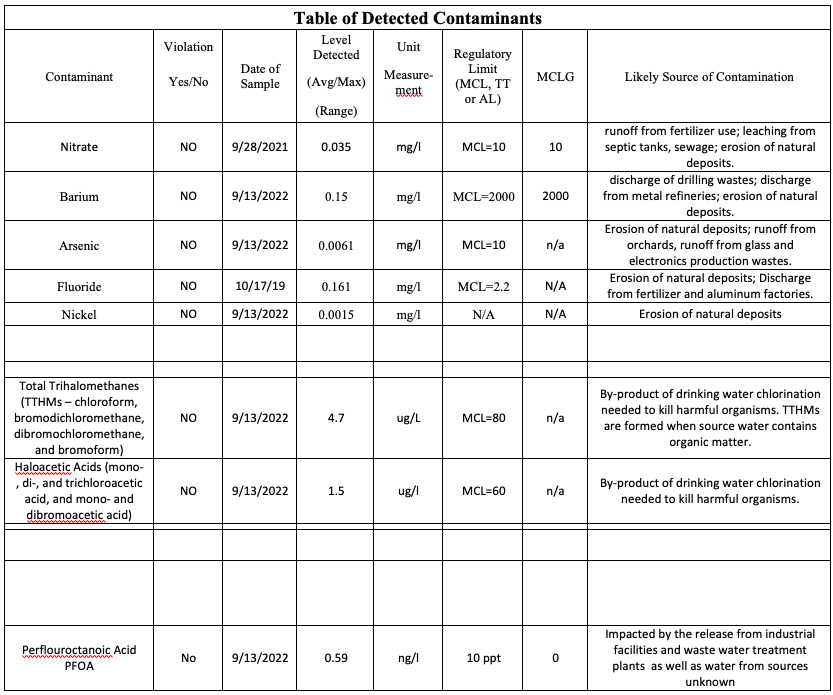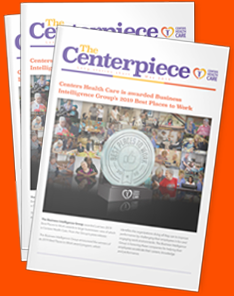Annual Drinking Water Quality Report for 2022
Cooperstown Center
128 Phoenix Mills Cross Road, Cooperstown, New York 13326
(Public Water Supply ID: NY3830079)
INTRODUCTION
To comply with State regulations Cooperstown Center will be annually issuing a report describing the quality of your drinking water for Cooperstown Center. The purpose of this report is to raise your understanding of drinking water and awareness of the need to protect our drinking water sources. Last year your tap water met all State drinking water health standards. We are proud to report that our system did not violate a maximum contaminant level or any other water quality standard. This report provides an overview of last year’s water quality. Included are details about where your water comes from, what it contains and how it compares to State standards. For more information please contact Shean Robinson, Director of Maintenance and water system at 607-544-2697. For additional information you are welcome to attend one of our staff meetings held daily in the administration suite at 9:00am/m-f. Shean is available at any time to discuss any water system questions.
WHERE DOES OUR WATER COME FROM?
In general, the sources of drinking water (both tap water and bottled water) include rivers, lakes, streams, ponds, reservoirs, springs and wells. As water travels over the surface of the land or through the ground, it dissolves naturally occurring minerals and can pick up substances resulting from the presence of animals or from human activities. Contaminants that may be present in source water include: microbial contaminants; inorganic contaminants; pesticides and herbicides; organic chemical contaminants. In order to ensure that tap water is safe to drink, the State and the EPA prescribe regulations which limit the amount of certain contaminants in water provided by public water systems. The State Health Departments and the FDA’s regulations establish limits for contaminants in bottled water which must provide the same protection for public health. The presence of contaminants does not necessarily indicate that water poses a health risk. More information about contaminants and potential health effects can be obtained by calling the EPA’s Safe Drinking Water Hotline (800-426-4791) or the Oneonta district office at (607-432-3911).
Our water system serves 174 Residents and 120 employees. Our water source is two groundwater wells. Well #1 is located 8’ off the Southwest corner of A-Wing and is 250 ft deep. Well #2 is located 46’ off the Southeast corner of B-Wing and is 238 ft deep. We pump from the wells on an alternating basis and do not draw from a surface of raw water source. The water is treated with chlorine before going into an 188,000 gallon storage tank. This process is monitored daily for correct levels. Chlorine is added to disinfect the well water of any contaminates and kept within NYSDOH guidelines. This is checked each day to maintain levels.
Potential sources of contamination for these wells would naturally include, but not be limited to, farming activities, erosion of natural deposits, soil and storm runoff. The well locations are constantly monitored for any activities that may contaminate them.
ARE THERE CONTAMINANTS IN OUR DRINKING WATER?
As the State regulations require, we routinely test your drinking water for numerous contaminants. These contaminants include: total coliform, inorganic compounds, nitrate, lead and copper, volatile organic compounds, total trihalomethane and synthetic organic compounds. The table presented below depicts which compounds were detected in your drinking water. The State allows us to test for some contaminants less than once per year because the concentrations of these contaminants do not change frequently. Some of our data, though repetitive, is more than one year old.
It should be noted that all drinking water, including bottle drinking water may be reasonably expected to contain at least small amounts of some contaminants. The presence of contaminants and potential health effects can be obtained by calling the EPA’s Safe Drinking Water Hotline (800) 426-4791 or the Oneonta (District Office) Health Department at (607) 432-3911.
WHAT DOES THIS INFORMATION MEAN?
As you can see by the table, our system had no violations. We have learned through our testing that some contaminants have been detected; however, these contaminants were detected below New York State requirements. In 2007 barium was detected in our cycle for these contaminants. Although it was well below the maximum contaminant levels (MCL’s), it still must be included in this report. Please refer to the table of detected contaminants for levels and possible contaminant sources.
Lead can cause serious health problems, especially for pregnant women and young children. Lead in drinking water is primarily from materials and components associated with service lines and home plumbing. Cooperstown Center is responsible for providing high quality drinking water and removing lead pipes but cannot control the variety of materials used in plumbing components in your home. You are responsible for protecting yourself and your family from lead in your home plumbing. You can take responsibility by identifying and removing lead materials within your home plumbing and taking the steps to reduce your family’s risk. Before drinking tap water, flush your pipes for several minutes by running your tap, taking a shower, doing laundry or a load of dishes. You can also use a filter certified by an American National Standards Institute accredited certifier to reduce lead in drinking water. If you are concerned about lead in your water and wish to have your water tested, contact Pace Analytical services at 518-884-0800. Information on lead in drinking water, testing methods and steps you can take to minimize exposure is available at epa.gov/safewater/lead.
Esta informe contiene información muy importante sobre su agua beber. Tradúzcalo con alguien que lo entienda bien.
Cerapport contient des informations importantes sur votre eau potable. Traduiesez-ou avec quelq’un qui le comprend bein.
IS OUR WATER SYSTEM MEETING OTHER RULES THAT GOVERN OPERATIONS?
During 2022, our system was in compliance with applicable State drinking water operating, monitoring and reporting requirements.
DO I NEED TO TAKE SPECIAL PRECAUTIONS?
Although our drinking water met or exceeded State and Federal regulations, some people may be more vulnerable to disease causing microorganisms or pathogens in drinking water than the general population. Immunocompromised persons such as persons with cancer undergoing chemotherapy, persons who have undergone organ transplants, people with HIV/AIDS or other immune system disorders, some elderly and infants can be particularly at risk from infections. These people should seek advice from their health care provider about their drinking water. EPA/CDC guidelines on appropriate means to lessen the risk of infection by Cryptosporidium, Giardia and other microbial pathogens are available from the Safe Drinking Water Hotline (800) 426-4791. EPA Website: epa.gov/safewater
Definitions:
- Maximum Contaminant Level (MCL): The highest level of a contaminant that is allowed in drinking water. MCLs are set as close to the MCLGs as feasible using the best available treatment technology.
- Maximum Contaminant Level Goal (MCLG): The level of a contaminant in drinking water below which there is no known or expected risk to health. MCLGs allow for a margin of safety.
- Action Level (AL): The concentration of contaminant, which if exceeded, triggers treatment, or other requirements, which a water system must follow.
- Milligrams per liter (mg/l): Corresponds to one part of liquid in one million parts of liquid (parts per million – ppm).
- Micrograms per liter (ug/l): Corresponds to one part of liquid in one billion parts of liquid (parts per billion – ppb).
- pCi/l: Picocurie per liter – A measure of the radioactivity in water.
- Maximum Residual Disinfectant Level (MRDL): the highest level of a disinfectant allowed in drinking water. There is convincing evidence that addition of a disinfectant is necessary for control of microbial contaminants.
- Maximum residual Disinfectant Level Goal (MRDLG): The level of a drinking water disinfectant below which there is no known or expected risk to health. MRDLGs do not reflect the benefits of the us of disinfectants to control microbial contamination.

* The level presented represents the 90th percentile of the 5 samples collected. The action level for neither lead nor copper was exceeded at any of the 5 sites tested.






